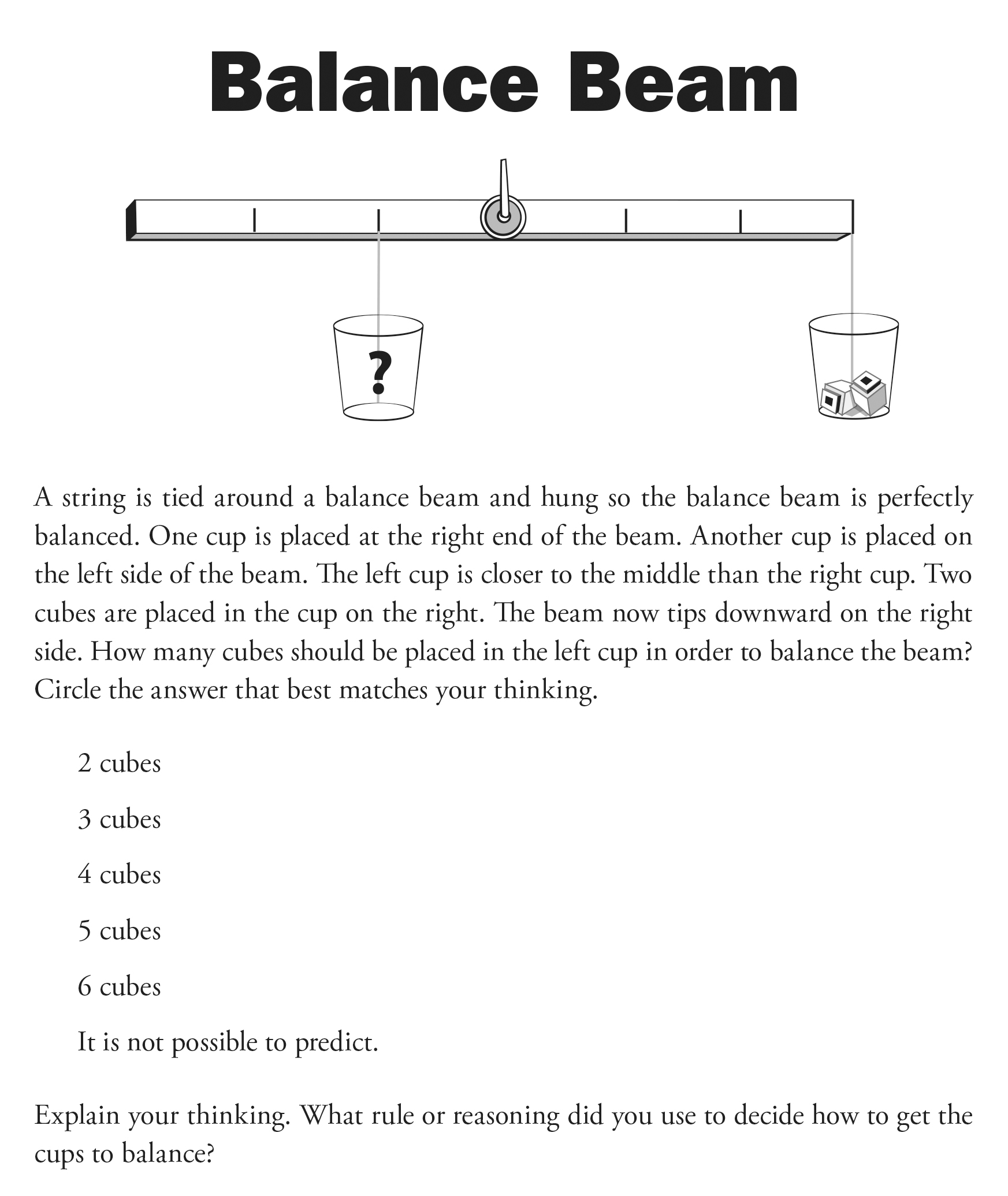Formative Assessment Probes
Balance Beam
Figuring Out a Mathematical Rule
By Page Keeley
In the elementary grades, children explore with balance beams to develop ideas about force, motion, and weight by hanging different combinations of objects to figure out how they balance. A balance beam has a long arm that rests on a single pivot point (fulcrum). As students place more weight on one side of the arm, they observe how gravity pulls the arm down. By placing an equal amount of weight in the same spot on the opposite arm, they observe how that arm is pulled down and the beam balances. Through exploration, they find that placing weights closer to the pivot point has less effect in pulling down the arm than placing weights at the end of the arm. As they interact with the balance beam, they begin to form an intuitive understanding of balanced forces. However, balance beams provide insight into more than early ideas about balanced forces—they also provide a window into students’ mathematical thinking.
The formative assessment probe “Balance Beam” (Figure 1) elicits students’ ideas about balancing (Keeley and Harrington 2010). It is also used to find out if students recognize that different amounts of weight can be balanced using a mathematical rule. This probe combines three dimensions: the disciplinary core idea of Forces and Motion, the scientific practice of Using Mathematics and Computational Thinking, and the crosscutting concept of Patterns.

Starting at a very young age, children have intuitive notions of moments (a moment refers to the measure of an object’s resistance to changes in its rotational motion). Piaget and Inhelder (1969) conducted early studies of children manipulating a balance beam scale. From their everyday experiences with seesaws, some children knew that a “weight” further away from the middle of the seesaw had a bigger effect than the same amount of weight near the middle. They also seemed to know how to intuitively achieve balance with different weights on a seesaw. Siegler (1982) conducted similar studies of balancing using a “rule assessment approach” and found that children go through four developmental stages in considering how to balance a beam. Young children (ages 4 and 5) consider only weight when deciding whether a beam will balance. Around age 6, children consider both weight and distance when the weights are the same. Around ages 7–9, children begin to consider both weight and distance but have difficulty predicting what would happen when one side has greater weight and the other side has greater distance. In the last stage (ages 10 and into adulthood), children use a mathematical rule to multiply distance by weight and compare the products to determine whether the beam will balance. As you use this probe, look for evidence of any one of these four developmental stages, keeping in mind that children may not be ready to describe the mathematical rule until the intermediate grades.
The best answer to the probe is six cubes. This is because the weights hanging closer to the pivot point have less of an effect on balancing than the weights that are hanging farther from the pivot point. To balance the beam, you must put more weight into the cup on the left. Some students may recognize that more weight is needed but fail to use the mathematical relationship between the weights and the number of beam intervals (distance).
To find the numerical answer, students need to understand that the distance between the hanging cubes (the weights) and the pivot point are just as important as the number of cubes. The product of 3 (number of units away from the pivot point) multiplied by 2 (the number of cubes) is equal to 6. This number must be equal to the same product on the left side in order for the arm to balance. Because the cup is hanging 1 unit away from the pivot point, the number of cubes must be 6 (6 × 1 = 6).
Listen carefully as children make their predictions and explain their reasons for their prediction. Listen for evidence of whether they consider weight only or weight and distance. For students who consider both weight and distance, encourage them to come up with a mathematical rule to support their prediction. After students have shared their thinking, provide them with balance beam scales to test their ideas. If balance beam scales are not available, a balance and fulcrum can be as simple as a flat board and wedge-shaped block. Unifix cubes can be substituted for weights. Have students further explore different combinations of weights and distances and discover the mathematical rule that applies to all their different combinations. For younger children, use the crosscutting idea of quantity. Listen for evidence of their growing mathematical understanding as they use quantity words to describe objects on each side of a balance, such as big, little, heavy, light, too much, and not enough.
This probe, coupled with opportunities to explore how a balance beam works, provide students with an early experience in understanding algebraic equations, long before they ever study algebra. The balance beam is a physical model of an algebraic equation. Both sides must equal the same amount and the fulcrum is the equal sign. The mathematical goal with elementary students is to have them figure out that whatever they put on one side must be proportionally equal to what they put on the other side. This can be done in different configurations with different numbers of objects, different weights, and different distances from the fulcrum, eventually realizing that different attributes can contribute to objects as well as numbers, equaling each other. For example 1 × 12 = 1 × 12 or 2 × 6 = 1 × 12 or 3 × 4 = 2 × 6. By “figuring it out” mathematically, students learn the importance of mathematics in helping them make predictions in science.


